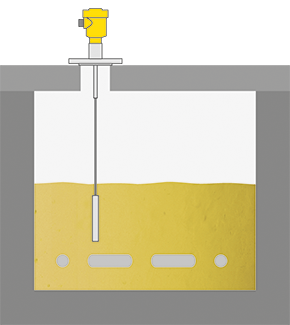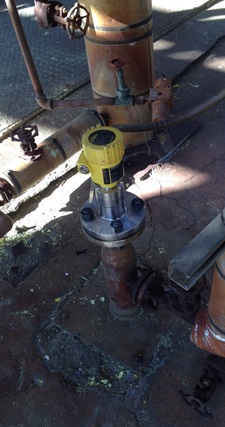Guided wave radar reads through buildup in the sulfur pit: Application of the month |
Oil refineries take raw crude oil and convert it into usable products for other industries and consumers. From beginning to end, a lot of unwanted substances are removed, some of which are dangerous, corrosive, or both.
One of the most dangerous and corrosive byproducts is found in the sulfur pit – a concrete pit for storing molten sulfur. This is where you’ll also find hydrogen sulfide, a colorless, flammable, poisonous, and corrosive gas. Maintaining a safe operating level in the sulfur pit is just as important as it is dangerous.
Overcoming a variety of challenges
Inside the sulfur pit, temperatures are elevated to prevent the sulfur from solidifying. However, if the temperature is upset, the sulfur can vaporize and crystalize. This results in excessive buildup throughout the inside of the sulfur pit, including on any level measurement instrumentation.
Buildup on most level measurement sensors results in a measurement error or a complete failure, leading to reduced efficiency in the sulfur recovery unit and eventual maintenance, repair, or replacement. The elevated temperatures and the chemical properties of the sulfur only add to the difficulties of this measurement.
Sulphur pit
Level measurement in sulphur pits
The liquid sulphur, which comes directly from the sulphur recovery plant, is stored in underground concrete pits. High temperatures are required to maintain the sulphur in its liquid form. The harsh, corrosive process and environmental conditions in sulphur pits require dependable level measurement.

Reliable
Unaffected by buildup or condensate
Cost effective
Maintenance-free operation
User friendly
Easy setup and installation
A robust sensor thrives in a difficult environment: VEGAFLEX 81
Guided wave radars like the VEGAFLEX 81 are able to measure level through excessive buildup because of how the technology works. A low amplitude, high-frequency microwave pulse is sent downward into the sulfur pit along a transmission probe. Once the pulse reaches the surface of the molten sulfur, the signal is reflected back to the sensor electronics, which uses the time of flight to calculate level. 
The VEGAFLEX 81 uses either a rod or cable probe in sulfur pit applications. As sulfur builds up on the probe, the microwave pulses begin to slow down as they travel down the probe. This slight change alters the time of flight, and operators may notice a small measurement discrepancy – one which is exacerbated at lower levels in the sulfur pit, but minimized at higher levels. This inconsistency due to the buildup can easily be accounted for and corrected.
As with any build up situation, sulfur crystallizes and builds up on the probe inside the sulfur pit until eventually, the buildup becomes too heavy and falls off. What remains is the amount of buildup that will be on the probe for the life of the instrument. It’s at this point shortly after installation, operators can recalibrate the sensor to get a more accurate level reading throughout the entire measurement span.
A reliable and accurate level measurement in the sulfur pit is critical due to the dangerous nature of the application. The VEGAFLEX 81 guided wave radar provides a solution where other technologies struggle and even fail due to the heat, corrosiveness, and excessive buildup of the molten sulfur.
Related products
Export this article
Download as PDFShare this article
Comments ({{comments.length}})
{{getCommentAuthor(comment, "Anonymous")}} {{comment.timestamp | date : "dd.MM.yyyy HH:mm" }}
{{comment.comment}}

